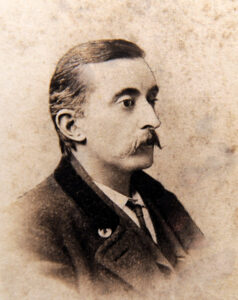Lafcadio Hearn
Author and journalist Lafcadio Hearn spent a number of years in New Orleans writing about Creole culture.

The Historic New Orleans Collection
A reproduction of a head and shoulders portrait of Lafcadio Hearn.
Though he was born in Greece and eventually became a citizen of Japan, writer Lafcadio Hearn made a tremendous impact on the literary life of New Orleans. Hearn spent about twelve years in the city, beginning in 1877. During his tenure, he wrote prolifically, publishing numerous newspaper articles, reviews, editorials, translations, poems, short stories, collections of tales, and a novel, Chita: A Memory of Last Island. In these and other publications, Hearn created particularly vivid and poplar images—helping to build myths about New Orleans that survive today. In New Orleans, he learned how to explain local, Creole culture to outsiders, and this skill in explaining one culture to another would serve him well when he left New Orleans to live in and write about Japan.
Early Life
Born June 27, 1850, on the Greek island of Lefkas, Patrick Lafcadio Hearn was the son of Charles Bush Hearn, an Irishman who served as a doctor in the British military. His mother, Rosa Antoniou Kassimati, was a Greek woman of humble origins. Abandoned by both his parents, who may not have been married, Hearn was sent to Dublin, Ireland, and then Durham, England, for his early education. At nineteen, he immigrated to Cincinnati, Ohio, where he began his apprenticeship as a journalist. Though he arrived quite poor, Hearn rapidly began to rise through the ranks at The Cincinnati Daily Inquirer. However, when word began to spread that he had married a black woman (Alethea “Mattie” Foley), he was fired for the crime of miscegenation, and went to work for The Cincinnati Commercial. There he began to cement his reputation as a talented reporter, particularly of events with sensational appeal or that involved the city’s underclasses, among whom he had a lived.
Hearn in New Orleans
In 1877 he moved to New Orleans, first to send dispatches to the Cincinnati newspaper but then to write for local newspapers such as The City Item and the well-established Times Democrat. Eventually, he contributed to the national periodicals Harper’s and Scribner’s. He spent just under twelve years in New Orleans, but these years served as a crucial apprenticeship for his later work. In the Crescent City, Hearn grew adept at explaining one culture to another. Specifically, he helped Uptown and American audiences understand downtown Creole culture. He brought the city to life for those outside it.
Hearn’s engagement with the local color of downtown New Orleans has never been matched. In fact, it would not be an overstatement to say that Hearn was a primary force in the creation of a symbolic or mythic New Orleans for a national audience. His discussions of Creole culture—–its medicines, cooking, music, Carnival tradition–and descriptions of the bayous, live oaks, and the French Quarter are legendary. The region’s weather, customs of dueling and funerary art, ghosts, voodoo, and other topics too plentiful to name all benefited from his rich description. The standard slogans of today’s tourist industry–that New Orleans is not quite American, that it is the City that Care Forgot and/or the Big Easy–may well have their origins in Hearn’s journalism.
As Frederick Starr notes, Hearn found New Orleans to be “a land of perfume and dreams,” and his productivity in the city was feverish. He wrote at least two thousand news articles, plus numerous reviews, editorials, translations, poems, and short stories. His novel, Chita: A Memory of Last Island, is about a devastating hurricane that hit Last Island in 1856. Published in 1888, it was an especially powerful evocation of the wetlands and barrier islands, now rapidly-eroding, off the coast of southeast Louisiana. Hearn depicted the world of the Creole aristocracy who enjoyed the area’s summer resorts.
Life After New Orleans
In 1887, Harper’s sent Hearn to the West Indies, where he worked for two years before moving to Japan in 1890. It was in Japan that Hearn achieved his greatest success. He became a respected university professor at the University of Tokyo, and married Setsu Koizumi, a samurai’s daughter. He also took the name Koizumi Yakumo. His writings in Japan included Glimpses of Unfamiliar Japan (1894); Out of the East: Reveries and Studies in New Japan (1895); Kokoro: Hints and Echoes of Japanese Inner Life (1896); Gleanings in Buddha-Fields: Studies of Hand and Soul in the Far East (1897); Exotics and Retrospectives (1898); Japanese Fairy Tales (1898); In Ghostly Japan (1899); and Shadowings(1900). With these and other publications, he played a central, historic role in illuminating what was then an otherwise opaque Japanese culture to Western audiences. He died in September 26, 1904, in Okubo, Japan.
